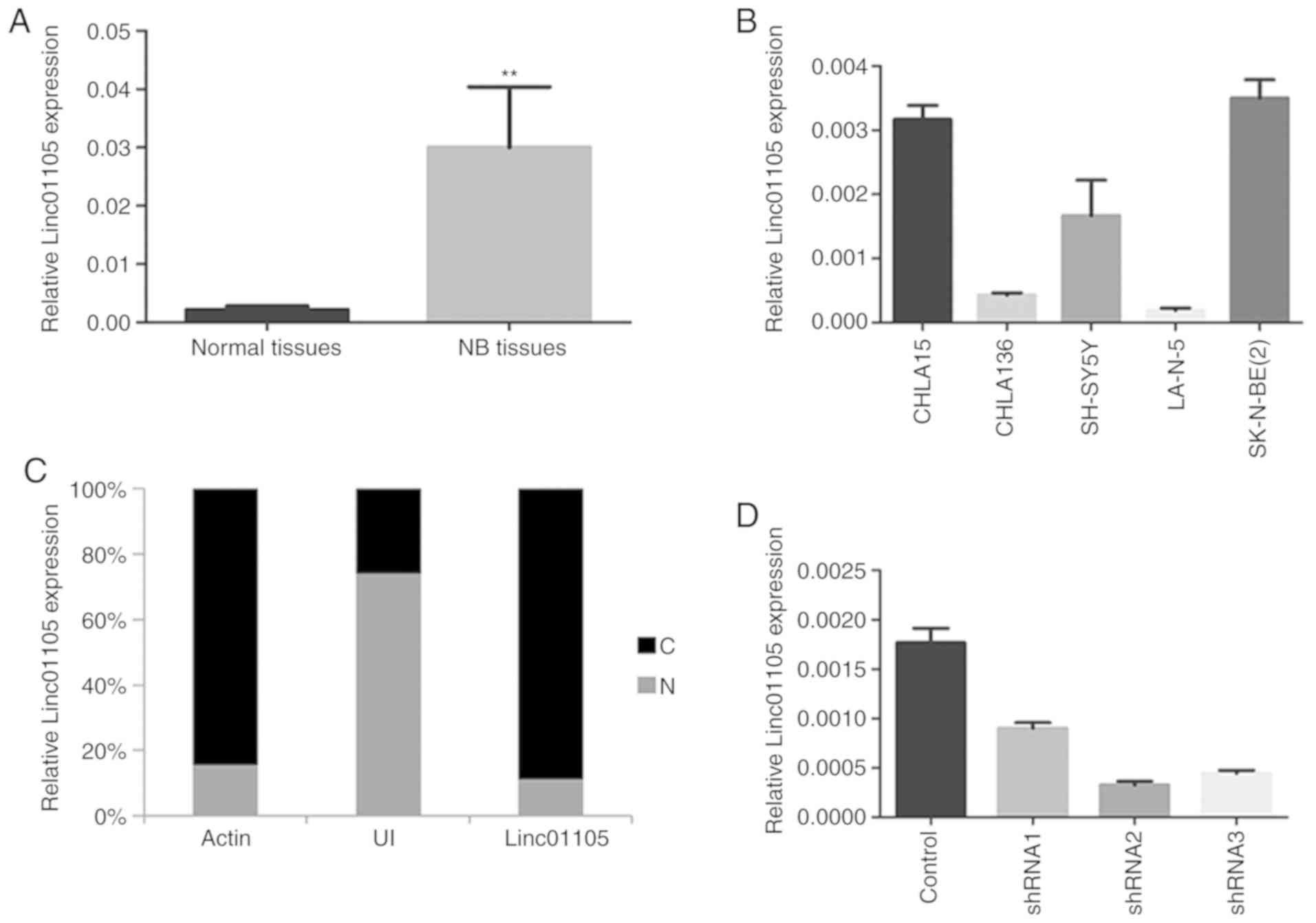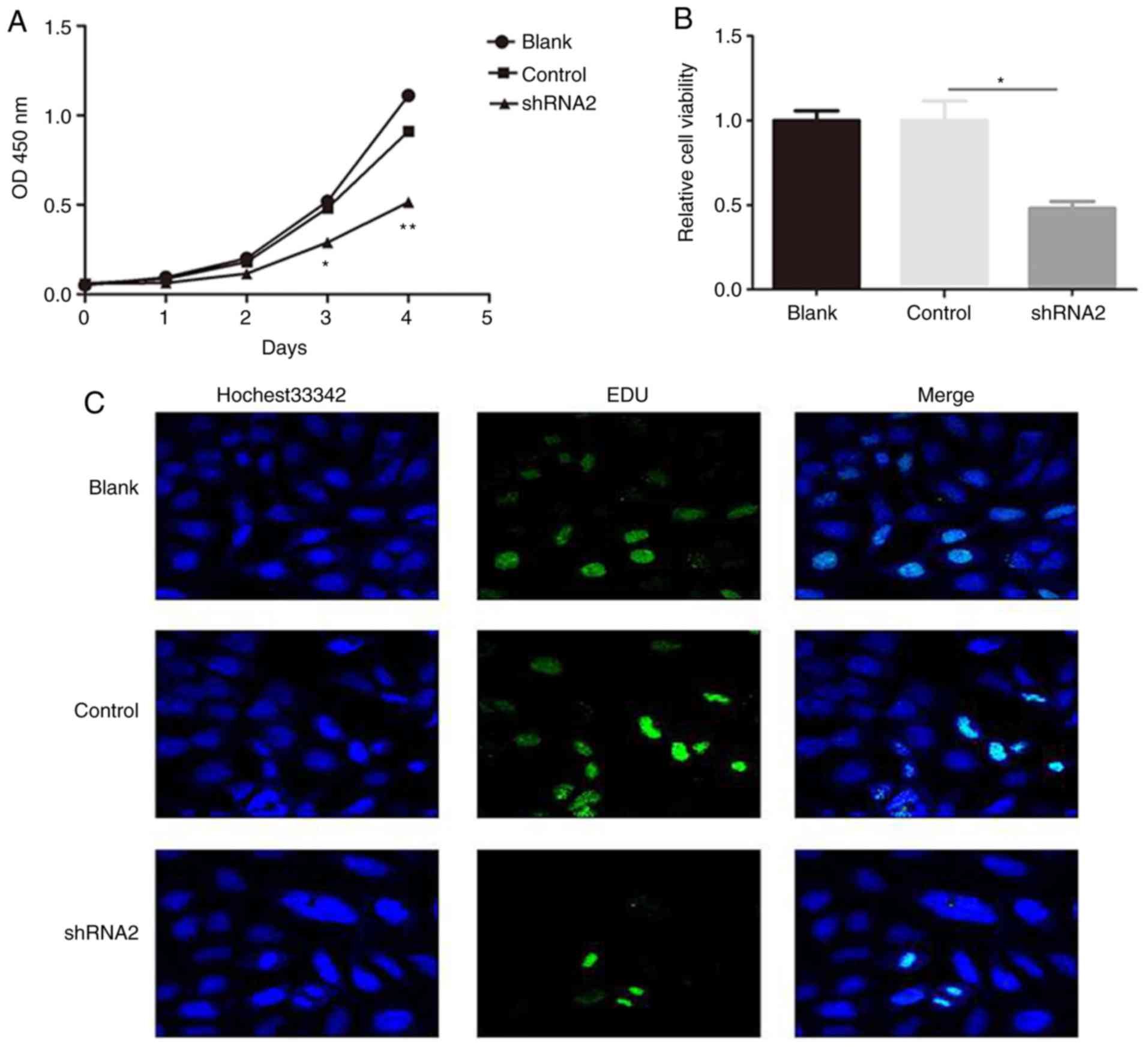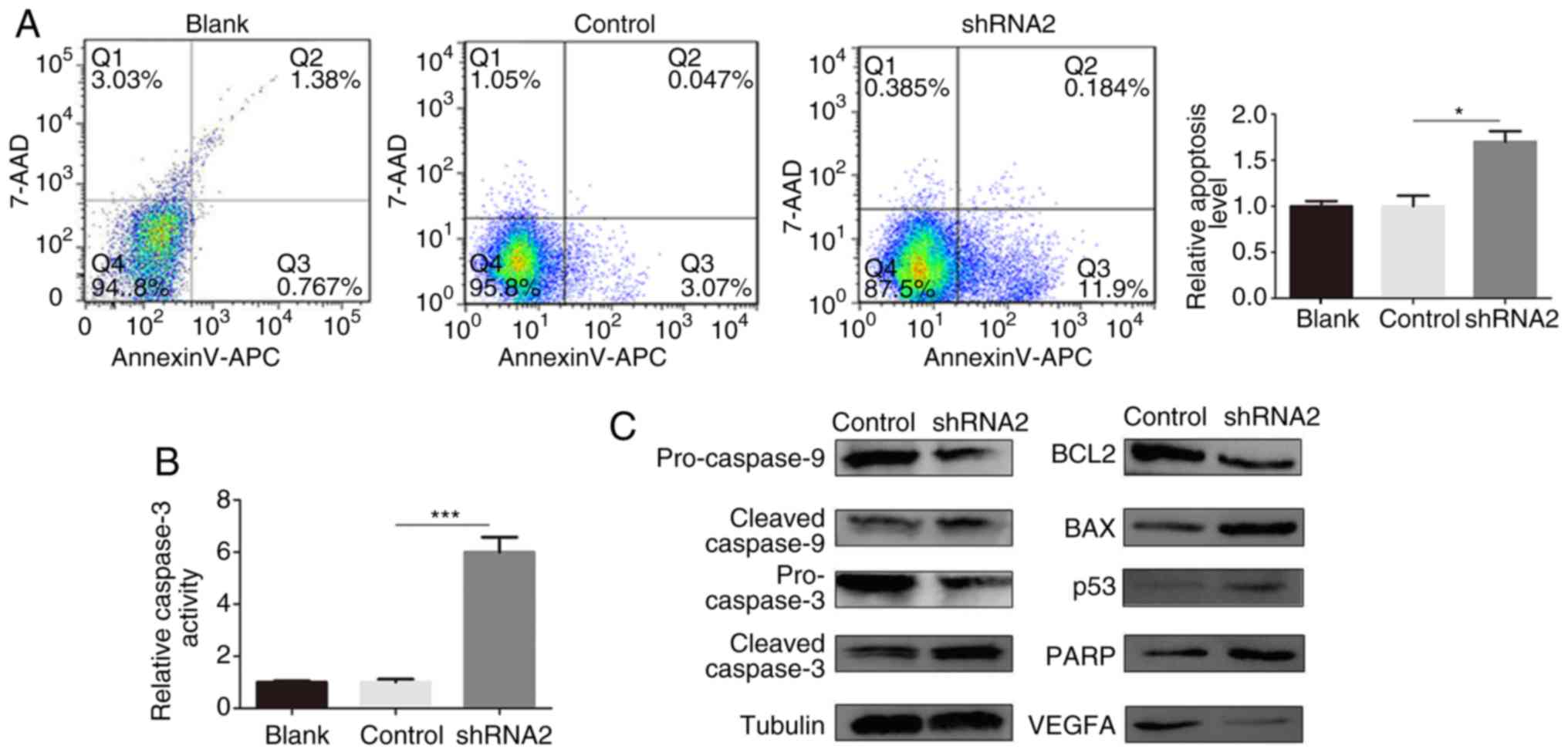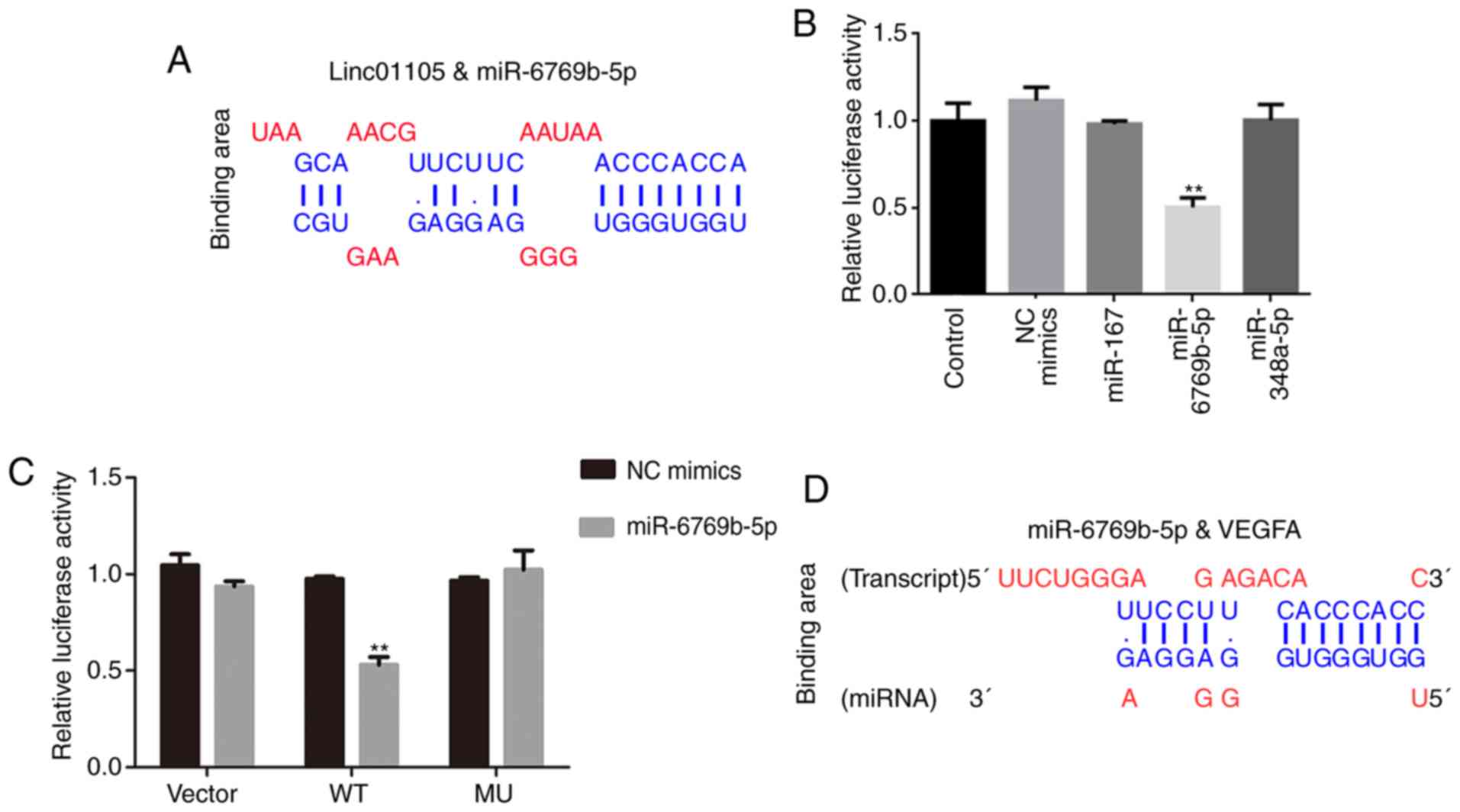|
1
|
Mondal T, Juvvuna PK, Kirkeby A, Mitra S,
Kosalai ST, Traxler L, Hertwig F, Wernig-Zorc S, Miranda C, Deland
L, et al: Sense-antisense lncRNA pair encoded by locus 6p22.3
determines neuroblastoma susceptibility via the USP36-CHD7-SOX9
regulatory axis. Cancer Cell. 33:417–434 e7. 2018. View Article : Google Scholar : PubMed/NCBI
|
|
2
|
Duan C, Wang H, Chen Y, Chu P, Xing T, Gao
C, Yue Z, Zheng J, Jin M, Gu W and Ma X: Whole exome sequencing
reveals novel somatic alterations in neuroblastoma patients with
chemotherapy. Cancer Cell Int. 18:212018. View Article : Google Scholar : PubMed/NCBI
|
|
3
|
Li Z, Takenobu H, Setyawati AN, Akita N,
Haruta M, Satoh S, Shinno Y, Chikaraishi K, Mukae K, Akter J, et
al: EZH2 regulates neuroblastoma cell differentiation via NTRK1
promoter epigenetic modifications. Oncogene. 37:2714–2727. 2018.
View Article : Google Scholar : PubMed/NCBI
|
|
4
|
Roy J and Mallick B: Investigating
piwi-interacting RNA regulome in human Neuroblastoma. Genes
Chromosomes Cancer. 57:339–349. 2018. View Article : Google Scholar : PubMed/NCBI
|
|
5
|
Singh N, Liu X, Hulitt J, Jiang S, June
CH, Grupp SA, Barrett DM and Zhao Y: Nature of tumor control by
permanently and transiently modified GD2 chimeric antigen receptor
T cells in xenograft models of neuroblastoma. Cancer Immunol Res.
2:1059–1070. 2014. View Article : Google Scholar : PubMed/NCBI
|
|
6
|
Wang F, Yang H, Deng Z, Su Y, Fang Q and
Yin Z: HOX antisense lincRNA HOXA-AS2 promotes tumorigenesis of
hepatocellular carcinoma. Cell Physiol Biochem. 40:287–296. 2016.
View Article : Google Scholar : PubMed/NCBI
|
|
7
|
Cheetham SW, Gruhl F, Mattick JS and
Dinger ME: Long noncoding RNAs and the genetics of cancer. Brit J
Cancer. 108:2419–2425. 2013. View Article : Google Scholar : PubMed/NCBI
|
|
8
|
Ding J, Xie M, Lian Y, Zhu Y, Peng P, Wang
J, Wang L and Wang K: Long noncoding RNA HOXA-AS2 represses P21 and
KLF2 expression transcription by binding with EZH2, LSD1 in
colorectal cancer. Oncogenesis. 6:e2882017. View Article : Google Scholar : PubMed/NCBI
|
|
9
|
Zheng H, Yang S, Yang Y, Yuan SX, Wu FQ,
Wang LL, Yan HL, Sun SH and Zhou WP: Epigenetically silenced long
noncoding-SRHC promotes proliferation of hepatocellular carcinoma.
J Cancer Res Clin Oncol. 141:1195–1203. 2015. View Article : Google Scholar : PubMed/NCBI
|
|
10
|
Dong R, Liu GB, Liu BH, Chen G, Li K,
Zheng S and Dong KR: Targeting long non-coding RNA-TUG1 inhibits
tumor growth and angiogenesis in hepatoblastoma. Cell Death Dis.
7:e22782016. View Article : Google Scholar : PubMed/NCBI
|
|
11
|
Wu L, Murat P, Matak-Vinkovic D, Murrell A
and Balasubramanian S: Binding interactions between long noncoding
RNA HOTAIR and PRC2 proteins. Biochemistry. 52:9519–9527. 2013.
View Article : Google Scholar : PubMed/NCBI
|
|
12
|
Tsai KW, Lo YH, Yeh CY, Chen YZ, Hsu CW,
Chen WS and Wang JH: Linc00659, a long noncoding RNA, acts as novel
oncogene in regulating cancer cell growth in colorectal cancer. Mol
Cancer. 17:722018. View Article : Google Scholar : PubMed/NCBI
|
|
13
|
Nallasamy P, Chava S, Verma SS, Mishra S,
Gorantla S, Coulter DW, Byrareddy SN, Batra SK, Gupta SC and
Challagundla KB: PD-L1, inflammation, non-coding RNAs, and
neuroblastoma: Immuno-oncology perspective. Semin Cancer Biol.
52:53–65. 2018. View Article : Google Scholar : PubMed/NCBI
|
|
14
|
Tang W, Dong K, Li K, Dong R and Zheng S:
MEG3, HCN3 and linc01105 influence the proliferation and apoptosis
of neuroblastoma cells via the HIF-1α and p53 pathways. Sci Rep.
6:362682016. View Article : Google Scholar : PubMed/NCBI
|
|
15
|
Russell MR, Penikis A, Oldridge DA,
Alvarez-Dominguez JR, McDaniel L, Diamond M, Padovan O, Raman P, Li
Y, Wei JS, et al: CASC15-S is a tumor suppressor lncRNA at the 6p22
neuroblastoma susceptibility locus. Cancer Res. 75:3155–3166. 2015.
View Article : Google Scholar : PubMed/NCBI
|
|
16
|
Liu PY, Erriquez D, Marshall GM, Tee AE,
Polly P, Wong M, Liu B, Bell JL, Zhang XD, Milazzo G, et al:
Effects of a novel long noncoding RNA, lncUSMycN, on N-Myc
expression and neuroblastoma progression. J Natl Cancer Inst.
106(pii): dju1132014.PubMed/NCBI
|
|
17
|
Li D, Wang X, Mei H, Fang E, Ye L, Song H,
Yang F, Li H, Huang K, Zheng L and Tong Q: Long noncoding RNA
pancEts-1 promotes neuroblastoma progression through
hnRNPK-mediated β-catenin stabilization. Cancer Res. 78:1169–1183.
2018. View Article : Google Scholar : PubMed/NCBI
|
|
18
|
Liang L, Xu J, Wang M, Xu G, Zhang N, Wang
G and Zhao Y: LncRNA HCP5 promotes follicular thyroid carcinoma
progression via miRNAs sponge. Cell Death Dis. 9:3722018.
View Article : Google Scholar : PubMed/NCBI
|
|
19
|
Zhang ZK, Li J, Guan D, Liang C, Zhuo Z,
Liu J, Lu A, Zhang G and Zhang BT: A newly identified lncRNA MAR1
acts as a miR-487b sponge to promote skeletal muscle
differentiation and regeneration. J Cachexia Sarcopenia Muscle.
9:613–626. 2018. View Article : Google Scholar : PubMed/NCBI
|
|
20
|
Livak KJ and Schmittgen TD: Analysis of
relative gene expression data using real-time quantitative PCR and
the 2(-Delta Delta C(T)) method. Methods. 25:402–408. 2001.
View Article : Google Scholar : PubMed/NCBI
|
|
21
|
Zhong J, Wang H, Chen W, Sun Z, Chen J, Xu
Y, Weng M, Shi Q, Ma D and Miao C: Ubiquitylation of MFHAS1 by the
ubiquitin ligase praja2 promotes M1 macrophage polarization by
activating JNK and p38 pathways. Cell Death Dis. 8:e27632017.
View Article : Google Scholar : PubMed/NCBI
|
|
22
|
Morelli C, Garofalo C, Sisci D, del Rincon
S, Cascio S, Tu X, Vecchione A, Sauter ER, Miller WH Jr and Surmacz
E: Nuclear insulin receptor substrate 1 interacts with estrogen
receptor alpha at ERE promoters. Oncogene. 23:7517–7526. 2004.
View Article : Google Scholar : PubMed/NCBI
|
|
23
|
Chu C, Quinn J and Chang HY: Chromatin
isolation by RNA purification (ChIRP). J Vis Exp. 25(pii):
39122012.
|
|
24
|
Gowda Saralamma VV, Lee HJ, Raha S, Lee
WS, Kim EH, Lee SJ, Heo JD, Won C, Kang CK and Kim GS: Inhibition
of IAP's and activation of p53 leads to caspase-dependent apoptosis
in gastric cancer cells treated with Scutellarein. Oncotarget.
9:5993–6006. 2017.PubMed/NCBI
|
|
25
|
Ehrnhoefer DE, Skotte NH, Ladha S, Nguyen
YT, Qiu X, Deng Y, Huynh KT, Engemann S, Nielsen SM, Becanovic K,
et al: p53 increases caspase-6 expression and activation in muscle
tissue expressing mutant huntingtin. Hum Mol Genet. 23:717–729.
2014. View Article : Google Scholar : PubMed/NCBI
|
|
26
|
Guo XX, Li Y, Sun C, Jiang D, Lin YJ, Jin
FX, Lee SK and Jin YH: p53-dependent fas expression is critical for
ginsenoside Rh2 triggered caspase-8 activation in HeLa cells.
Protein Cell. 5:224–234. 2014. View Article : Google Scholar : PubMed/NCBI
|
|
27
|
Rong B and Yang S: Molecular mechanism and
targeted therapy of Hsp90 involved in lung cancer: New discoveries
and developments (Review). Int J Oncol. 52:321–336. 2018.PubMed/NCBI
|
|
28
|
Gao C, Peng YN, Wang HZ, Fang SL, Zhang M,
Zhao Q and Liu J: Inhibition of heat shock protein 90 as a novel
platform for the treatment of cancer. Curr Pharm Des. 25:849–855.
2019. View Article : Google Scholar : PubMed/NCBI
|
|
29
|
Chen Q, Deng R, Zhao X, Yuan H, Zhang H,
Dou J, Chen R, Jin H, Wang Y, Huang J and Yu J: Sumoylation of
EphB1 suppresses neuroblastoma tumorigenesis via inhibiting PKCγ
activation. Cell Physiol Biochem. 45:2283–2292. 2018. View Article : Google Scholar : PubMed/NCBI
|
|
30
|
Batzke K, Büchel G, Hansen W and Schramm
A: TrkB-target galectin-1 impairs immune activation and radiation
responses in neuroblastoma: Implications for tumour therapy. Int J
Mol Sci. 19(pii): E7182018. View Article : Google Scholar : PubMed/NCBI
|
|
31
|
Szemes M, Greenhough A, Melegh Z, Malik S,
Yuksel A, Catchpoole D, Gallacher K, Kollareddy M, Park JH and
Malik K: Wnt signalling drives context-dependent differentiation or
proliferation in neuroblastoma. Neoplasia. 20:335–350. 2018.
View Article : Google Scholar : PubMed/NCBI
|
|
32
|
Yang S, Xu J and Zeng X: A six-long
non-coding RNA signature predicts prognosis in melanoma patients.
Int J Oncol. 52:1178–1188. 2018.PubMed/NCBI
|
|
33
|
Yamada A, Yu P, Lin W, Okugawa Y, Boland
CR and Goel A: A RNA-Sequencing approach for the identification of
novel long non-coding RNA biomarkers in colorectal cancer. Sci Rep.
8:5752018. View Article : Google Scholar : PubMed/NCBI
|
|
34
|
Huang T, Wang M, Huang B, Chang A, Liu F,
Zhang Y and Jiang B: Long noncoding RNAs in the mTOR signaling
network: Biomarkers and therapeutic targets. Apoptosis. 23:255–264.
2018. View Article : Google Scholar : PubMed/NCBI
|
|
35
|
Janakiraman H, House RP, Gangaraju VK,
Diehl JA, Howe PH and Palanisamy V: The long (lncRNA) and short
(miRNA) of It: TGFβ-mediated control of RNA-binding proteins and
noncoding RNAs. Mol Cancer Res. 16:567–579. 2018. View Article : Google Scholar : PubMed/NCBI
|
|
36
|
Chen X, Chen Z, Yu S, Nie F, Yan S, Ma P,
Chen Q, Wei C, Fu H, Xu T, et al: Long noncoding RNA LINC01234
functions as a competing endogenous RNA to regulate CBFB expression
by sponging miR-204-5p in gastric cancer. Clin Cancer Res.
15:2002–2014. 2018. View Article : Google Scholar
|
|
37
|
Liu XH, Sun M, Nie FQ, Ge YB, Zhang EB,
Yin DD, Kong R, Xia R, Lu KH, Li JH, et al: Lnc RNA HOTAIR
functions as a competing endogenous RNA to regulate HER2 expression
by sponging miR-331-3p in gastric cancer. Mol Cancer. 13:922014.
View Article : Google Scholar : PubMed/NCBI
|
|
38
|
Xie CR, Wang F, Zhang S, Wang FQ, Zheng S,
Li Z, Lv J, Qi HQ, Fang QL, Wang XM and Yin ZY: Long noncoding RNA
HCAL facilitates the growth and metastasis of hepatocellular
carcinoma by acting as a ceRNA of LAPTM4B. Mol Ther Nucleic Acids.
9:440–451. 2017. View Article : Google Scholar : PubMed/NCBI
|
|
39
|
Zhao X, Liu Y, Li Z, Zheng S, Wang Z, Li
W, Bi Z, Li L, Jiang Y, Luo Y, et al: Linc00511 acts as a competing
endogenous RNA to regulate VEGFA expression through sponging
hsa-miR-29b-3p in pancreatic ductal adenocarcinoma. J Cell Mol Med.
22:655–667. 2018. View Article : Google Scholar : PubMed/NCBI
|
|
40
|
Weng WC, Lin KH, Wu PY, Ho YH, Liu YL,
Wang BJ, Chen CC, Lin YC, Liao YF, Lee WT, et al: VEGF expression
correlates with neuronal differentiation and predicts a favorable
prognosis in patients with neuroblastoma. Sci Rep. 7:112122017.
View Article : Google Scholar : PubMed/NCBI
|
|
41
|
Fakhari M, Pullirsch D, Paya K, Abraham D,
Hofbauer R and Aharinejad S: Upregulation of vascular endothelial
growth factor receptors is associated with advanced neuroblastoma.
J Pediatr Surg. 37:582–587. 2002. View Article : Google Scholar : PubMed/NCBI
|
|
42
|
Weng WC, Lin KH, Wu PY, Lu YC, Weng YC,
Wang BJ, Liao YF, Hsu WM, Lee WT and Lee H: Calreticulin regulates
VEGF-A in neuroblastoma cells. Mol Neurobiol. 52:758–770. 2015.
View Article : Google Scholar : PubMed/NCBI
|
|
43
|
Kaneko S, Ishibashi M and Kaneko M:
Vascular endothelial growth factor expression is closely related to
irinotecan-mediated inhibition of tumor growth and angiogenesis in
neuroblastoma xenografts. Cancer Sci. 99:1209–1217. 2008.
View Article : Google Scholar : PubMed/NCBI
|
|
44
|
Yin CP, Guan SH, Zhang B, Wang XX and Yue
SW: Upregulation of HIF-1α protects neuroblastoma cells from
hypoxia-induced apoptosis in a RhoA-dependent manner. Mol Med Rep.
12:7123–7131. 2015. View Article : Google Scholar : PubMed/NCBI
|
|
45
|
Westerlund I, Shi Y, Toskas K, Fell SM, Li
S, Surova O, Södersten E, Kogner P, Nyman U, Schlisio S and
Holmberg J: Combined epigenetic and differentiation-based treatment
inhibits neuroblastoma tumor growth and links HIF2α to tumor
suppression. Proc Natl Acad Sci USA. 114:E6137–E6146. 2017.
View Article : Google Scholar : PubMed/NCBI
|
















